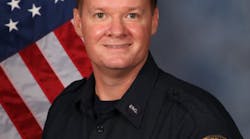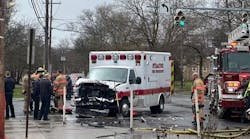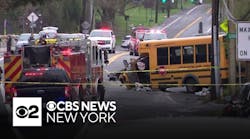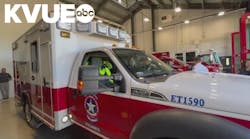What the authorities did not know initially was that an extremist religious group, Aum Shinrikyo (Supreme Truth), had declared war on the government and was carrying out a terrorist attack against civilians. Enraged by actions the Japanese government had taken to curtail its activities, the group allegedly carried out the attack with one of the world's most lethal forms of chemical agent, Sarin nerve gas. This nerve gas, even in a highly diluted form, can be fatal if contacted or inhaled.
Sarin was discovered in Germany before World War II by scientists developing pesticides. While experimenting with organic phosphorous compounds, they created poisons that were highly lethal against insects but so potent that they were fatal to humans. The compounds have an immediate disruptive effect on the body's central nervous system and can cause death in just minutes.
The application of these nerve agents Sarin, Soman and Tabun to weapons of war was quickly appreciated by the German military, which began a secret program to stockpile nerve gas for artillery and aerial bombs. (At the close of the war, the Germans had begun to develop a Sarin gas warhead for their V-2 rocket.) The grand scheme of Hitler's was thwarted as the time needed to complete the project ran out. (See story on facing page.)
In the Tokyo incident, authorities were faced with train passengers in a panic as the colorless and odorless Sarin caught its victims totally unaware. Thousands fled the trains and platforms for the exits to the streets and fresh air. People emerged on the streets covering their faces and collapsing as the effects of the gas overtook them.
Initially, none of the emergency services responders understood a terrorist action was in progress. Certainly no one realized they were being exposed to highly lethal nerve agent. As treatment for the injured began in earnest, their common symptoms of dizziness, blurred vision, constricted pupils, foaming saliva at the mouth and, in some cases, severe muscular convulsion revealed a pattern. Doctors at the scene suddenly understood the cause as nerve agent and ordered atropine injections for all symptomatic patients. The actions of the police and firefighters were heroic as they suffered exposure injuries while treating those in need.
As circumstances stabilized, police determined that chemical devices had been placed on trains of three separate commuter lines that converge at the Kasumigaseki Station (the hub of the government offices). These trains would have arrived during the peak of rush hour within minutes of each other, creating a much larger killing zone. As the devices began to emit their deadly fumes, however, the trains stopped short at outlying stations. The final count was 12 dead and over 5,000 injured (Time, April 10, 1994).
The terror felt by all who were attacked was staggering. Although nerve gas attacks have allegedly taken place in wartime, this was the first reported use by a group in what could be characterized as a terrorist action against civilians. Police raided locations of Supreme Truth members and confiscated large quantities of organic phosphorous chemical, the base ingredient of Sarin. These were homemade devices of a crude construction, yet insidiously effective.
The federal agencies responsible for monitoring the activities of suspected terrorist organizations were deeply disturbed by the Tokyo attack. Terrorism has taken many forms, including bombing, shooting, hijacking and assassination. In the past, those carrying out the terror have seemingly been satisfied with the use of conventional weapons and tactics in destroying their targets. The use of nerve agent against the public in Tokyo was a significant departure.
That members of Supreme Truth were able to manufacture the Sarin gas device was not surprising the required chemicals and technical literature to make such weapons are available in the commercial marketplace. The shock was the group's willingness to use such an insidious method to terrorize. For many years, the nations of the world have been working on biological weapon and chemical weapon conventions that would forever ban the use of these non-conventional weapons. The biological convention has been ratified by the required number of countries to make the ban on their use an internationally recognized law. The chemical weapons convention, however, has a number of holdouts, including the United States (the government is unsure whether an international ban on chemical weapons is in the country's best interest).
The widespread use of chlorine gas, mustard gas and phosgene during the trench warfare of World War I led most combatants to agree never to use them again in conflicts. The apocalyptic nature of this kind of war instilled fear of the complete annihilation of all parties in a conflict without a shot being fired. Even though many of these weapons remain in our arsenal, it is almost universally accepted that they should never be used. Yet when Sarin gas was used in Tokyo, it was as if the veil on the unspoken threat had been lifted.
Copycat crime has been well documented in the world of terrorism (witness the rash of jetliner hijackings in the late 1960s). The possibility of a Tokyo-style attack in a large U.S. city was tangible enough for federal officials to call for meetings with state and local authorities during the summer of 1994. A follow-up conference was held that November in Bethesda, MD. Emergency service and police department representatives from throughout the United States were present. Attendees were warned by federal agents that they had to anticipate terrorist action using chemical weapons and that they needed to assess their capabilities for handling such an eventuality.
Upon his return from this conference, FDNY Chief Thomas Haring, supervisor of the department's hazardous materials section, briefed Chief James Bullock, head of the FDNY Special Operations Command, on the chemical agent use in Japan and the department's current capability to respond to such an attack.
At a drill, the department tested its competency and readiness to handle such an incident and found deficiencies. Bullock's Special Operations chiefs Haring, Ray Downey, Craig Shelley and John Paolillo determined that the department would use its qualified instructors to develop and train more personnel, augment equipment and enhance response capabilities to deal with a potential attack of this kind. The hazmat section had state-of-the-art equipment for handling man-made disasters but its resources would be limited in a large-scale attack with chemical weapons. In reassessing its capabilities, the department surveyed its members to ascertain which of them had received "NBC" (nuclear, biological and chemical) training through military units. These personnel would be used to augment fire department technical specialists to improve the department's ability to respond.
Contacting these members and using their expertise let the department "jump-start" its preparations. One firefighter, Robert J. Milmore of Rescue Company 3, had completed the U.S. Army's Chemical Officer Advanced Course and was a special staff adviser for NBC preparations while assigned to U.S. forces in Operation Desert Storm (the Persian Gulf war). Milmore recommended to the department that a close interface with the local Army command would be invaluable for borrowing equipment needed for training and preparation.
Milmore also recommended that FDNY incorporate its procedures around the Army's three-step approach to NBC operations: detect, protect and decontaminate. The fire department has a generally accepted nine-step process isolation, notification, identification, protection, spill, leak, fire control, recovery and termination. (The FDNY must consider OSHA mandates, while the military on the battlefield does not.)
At Bullock's direction, the hazmat section was given overall responsibility to develop plans and procedures to meet this potential threat. Haring identified the Special Operations Command personnel (rescue and squad members) as the initial group to be trained. About 300 firefighters were trained by the hazmat section in procedures for using Level A protective clothing and chemical detection monitors as well as decontamination. Exercise evaluations with other city agencies (including police and EMS) were planned with a scenario similar to the Tokyo incident, the goal being the availability of specially trained personnel who could restore the city to normal as quickly as possible, lessening the impact of such an attack.
The Level A suit selected by the FDNY is a fully encapsulated suit with self-contained breathing apparatus (SCBA). It provides about one hour of air before the air supply must be replenished. (The suit must be opened for replenishment.) As a safety procedure, all personnel were medically monitored prior to donning the suits. Working within the confines of the suit can be exhausting. Increased respiration and blood pressure levels are common.
Advantages of the Level A suit over comparable military garments are that it can be worn for prolonged periods in a liquid contamination circumstance and no changing of mask filters is required, as with a military gas mask. Disadvantages are the suit's bulkiness, loss of some manual dexterity and a significant reduction in the pace of work. During training, a small number of personnel complained of claustrophobia while working in the suit. Additionally, two-way communication is limited to hand movement and signals. The operator can carry a handi-talkie in the suit but maneuvering to key the microphone is difficult.
Milmore coordinated with the 77th Army Reserve Command, which supplied monitoring and detection equipment for the initial training. The FDNY used the M-8 chemical alarm, M-9 detection paper, M-256 personal decontamination kit and M-258 monitoring/detecting kit (all miliary designations). Also, the department purchased a microsensor and chemical alarm monitor (CAM), a hand-held device sensitive to minute traces of toxins in the atmosphere. The responders were trained in:
- Chemical and biological agents and the weapons known to exist, as well as the manner in which they may be employed.
- The effects of weather conditions on the application of the weapons.
- How to recognize the symptoms of a person exposed to nerve agent and the initial methods to decontaminate and treat.
- Various chemical alarms and detection equipment. Procedures were developed to integrate this equipment into the basic "hot" response procedure.
On Sept. 23, 1995, the department participated in a large-scale exercise with the city's Transit Authority, police department and EMS involving a Tokyo-type chemical attack. The exercise began with a simulated 911 call from the subway station at 57th Street and 6th Avenue in Manhattan. The report to 911 was "people being overcome by fumes."
A fire department dispatcher sent the first-due unit, Ladder Company 4, to the scene. Suspecting toxic fumes or smoke, firefighters donned bunker gear and SCBA. As Lieutenant Jack Flaherty got closer to the response area, he encountered more and more victims collapsed on the station platform. He transmitted a 10-80 code (mass casualty) to the dispatcher, reporting a toxic gas situation. The dispatcher notified hazmat and rescue units to respond. EMS and the police also were told to respond.
At the scene, the ladder company members removed victims. They stayed clear of the source of contamination and were relatively safe from most vapor agents by the bunker gear and SCBA. (That, however, would not protect a firefighter from a chemical liquid agent.) On the subway platform, one floor above, an engine company that had arrived at the scene was directed to stretch a charged line for purposes of "gross" decontamination. Gross decontamination consists of using large quantities of water to dilute the chemical contamination.
On the street, police, EMS and fire department personnel established "deliberate" decontamination stations to treat victims. Deliberate decontamination stations consist of a series of small rubber baths with a chlorine bleach solution where the victim is scrubbed and clothes removed. The discarded clothing is packed in plastic bags and sealed for disposal. All station personnel were in Level A suits while performing decontamination. Once "cleared," victims were taken to vehicle-mounted portable showers, washed and moved to EMS ambulances and transported to hospitals.
Victims with symptoms of nerve agent poisoning would be treated by EMS personnel with Atropine and 2-Pan-Chloride, an antidote for nerve agent. EMS policy is not to transport any contaminated patient because that would lead to secondary contamination of EMS or hospital personnel. Secondary exposure to nerve agent is as deadly as the initial attack responders at the Tokyo incident became victims in this manner.
As lifesaving procedures were ongoing, the hazmat detection team proceeded to the response area to locate the source of contamination. Two two-member teams equipped with hand-held CAMs, M-8 alarms and M-9 and M-8 paper moved throughout the affected area to determine the source of the agent and direct the decontamination team to contain and neutralize the source. M-8 alarms were positioned at the subway entrance and subway vents to determine that the vapor hazard had not escaped into the surrounding atmosphere. (The M-8 and M-9 papers detect nerve agent only in its liquid form; the CAM and M-8 alarm detect nerve agent only in its vapor form).
The results of this drill were mostly positive and the Transit Authority felt the city's emergency services could respond successfully to an attack of this nature. Lessons learned included the lessened manual dexterity while working in the Level A suit and poor communications among personnel in the response area. On a positive note was the cooperation with local military units, which contributed the use of their NBC equipment to the training.
Put To The Test
In October 1995, two events of worldwide interest took place in New York City with the visit of Pope John Paul II early in the month, followed by the arrival of over 100 world leaders for the United Nations' 50th anniversary celebration. Based on intelligence reports of possible terrorist attacks against the pope and other leaders, the fire department and other city agencies had to address any possible threat.
The FDNY's role in the security plan was to protect dignitaries in the event of an aircraft accident at airports and heliports and to have a trained response team to react to any terrorist chemical attack. Close coordination with the U.S. Secret Service was paramount in gaining access to the areas to be protected. During these events, response teams made up of hazmat, rescue and squad companies established detection and monitoring posts at a number of the arrival points, including the UN complex, the Wall Street Heliport, Aqueduct Raceway and Central Park (the latter two were sites of papal Masses).
M-8 alarms, CAMs and personnel in Level A clothing were in position and ready to respond at each of these locations. If an attack had taken place at any of these points, it would have been immediately detected and contained. The fact that chemical agents are most effective when deployed upwind of the target enabled the fire department personnel to position monitoring equipment upwind of the VIP areas. This insured Secret Service personnel that they would receive an early warning to evacuate dignitaries.
The prior in-service training and practice drills enabled the department to accomplish its mission. Ongoing training with the FBI terrorist task force and the Army Chemical Corps will enable the fire department to continue to provide a high state of readiness.
The lessons of Tokyo are many. Emergency services personnel must be aware of the potential use of such weapons. Close coordination among fire, police and EMS personnel is vital for successfully dealing with terrorist attacks of this nature. There is no substitute for vigilance.
The Deadly Nature Of Nerve Gas
Nerve gas was discovered on Dec. 23, 1936, by Dr. Gerhard Schrader, a German scientist researching new insecticides. The agent was extremely potent to insects but also caused nasty side effects to the inventor. His vision and muscular coordination were temporarily hampered. In 1938, he isolated a derivative of Tabun (isopropyl methylphonoflouridate). It was much more deadly than its predecessor
Schrader named the substance Sarin after the four men involved in its development (Schrader, Ambros, Ruedriger and van der Linden). It was this substance the Germans began to stockpile for use in bombs and warheads. It wasn't until after World War II that the Allies discovered Germany's dark secret.
Nerve gas attacks the body by inhibiting the action of a chemical called cholinesterase. This chemical controls muscles by breaking down acetylcholine, a chemical that causes muscular contraction. If this is not done, the level of acetylcholine in the body builds up to a disastrous level, sending all muscles of the body into contractions. The body thus poisons itself, as it loses control of all its functions. The muscles of the arms and legs, along with those which control respiration and defecation, go into a state of violent vibration. Death comes as a result of asphyxiation (A Higher Form of Killing: The Secret Story of Chemical and Biological Warfare by Robert Harris and Jeremy Paxman, Hill and Wang Press, 1982).
Inhaled nerve agent can produce casualties within minutes. For personnel engaged in mild activity, the median lethal dosage by inhalation is about 70 mg-min/m3. As an example, 50 percent of a group of unprotected personnel breathing at a normal rate of 15 liters per minute and exposed to 70 milligrams of Sarin per cubic meter of air for one minute will die if they do not receive medical treatment. For personnel involved in activities that increase breathing rate, the median lethal dosage can be as low as 20 mg-min/m3.
Incapacitation (muscle contraction and dimmed vision) occurs at approximately 35 milligrams for mild breathing rates. Very small concentrations of the vapor can incapacitate its victims. Vapor concentrations in a cubic meter would weigh less than 1/100th of an ounce at a lethal level ("Employment of Chemical Agents" Department of the Army Field Manual 3-10, Change 2, Feb. 28, 1971).
Robert J. Milmore and Thomas A. McHale
Robert J. Milmore is an FDNY firefighter assigned to Rescue Company 3 in the Bronx. He is also a captain in the U.S. Army Reserve and was assigned as a medevac helicopter pilot to the 336th Medical Detachment (Air Ambulance) and as a chemical officer during the Persian Gulf war. Milmore is a graduate of the U.S. Army Chemical Officer's Advanced Course and was advisor to the command on all matters relating to "NBC" (nuclear, biological and chemical) operations during the war. He received the Bronze Star for his actions. Thomas A. McHale is a commercial airline pilot and a U.S. Army Reserve lieutenant colonel. He commanded the 336th Medical Detachment during the Gulf war and worked closely with Milmore in NBC operations.








